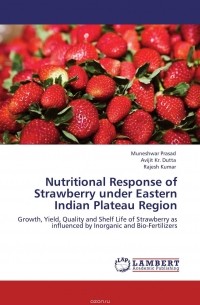Avijit Kr. Dutta — новинки
-
 Rajesh Kumar, Avijit Kr. Dutta, Muneshwar Prasad
Nutritional Response of Str...
Rajesh Kumar, Avijit Kr. Dutta, Muneshwar Prasad
Nutritional Response of Str...
ISBN: 9783659110023 Год издания: 2012 Издательство: LAP LAMBERT Academic Publishing Язык: Английский Аннотация
Strawberry is one of the most delicious and refreshing soft fruit of the world. It is mainly grown in temperate climate but varieties are available which can successfully be cultivated in subtropical or even in tropical climate as well. Growth, yield and quality of strawberry fruits are highly influenced by the application of different bio-fertilizers in combination with inorganic fertilizers. Thereby, the present research has been conducted to identify the suitable combination of inorganic and bio-fertilizers for getting higher yield of quality fruit as well as their longer storage life. The results of the present study revealed that the plant growth, yield and fruit quality parameters significantly increased with the application of (NPK+ Azotobacter+ PSB). The study also exposed that the availability of soil nitrogen, phosphorus and potassium in strawberry crop ecosystem improved with the application of (NPK+ Azotobacter + PSB). While the minimum physiological losses and minimum spoilage losses of fruit were recorded with the inoculation of bio-fertilizers (Azotobacter+ PSB) only. We hope both researchers and growers would obviously be benefitted from the findings of this study. -
 Rajesh Kumar, Avijit Kr. Dutta
Eco-Friendly Approaches To ...
Rajesh Kumar, Avijit Kr. Dutta
Eco-Friendly Approaches To ...
ISBN: 9783848416844 Год издания: 2012 Издательство: LAP LAMBERT Academic Publishing Язык: Английский Аннотация
Two major insect-pests viz. Diamond Back Moth (DBM) [Plutella xylostella] and two species of aphid such as Indian Mustard Aphid [Lipaphis erysimi] and Green Peach Aphid [Myzus persicae] are found detrimental for the cultivation of cabbage [Brassica oleracea var. capitata]. Different bio-pesticides were reported to be effective in suppressing the population of DBM and aphids infesting cabbage. Thus an attempt has been made in the present investigation to find the efficacy of different bio-pesticides on leading insect-pests of cabbage. Due to minimum infestations of these pests after the application of different bio-pesticides such as cow urine, garlic + chilli extract, neem based insecticide like vanguard, Bacillus thuringiensis var. kurstaki (B.t.k) etc. and incorporation of different inter crop components like garlic (Allium sativum), coriander (Coriandrum sativum), African marigold (Tagetes erecta), fenugreek (Trigonella foenum-graecum), tomato (Solanum lycopersicum) and French bean (Phaseoulus vulgaris) the highest yield as well as benefit cost ratio was received. We hope this book will help to all researchers and growers for growing the safest cabbage for human consumption. -
 Avijit Kr. Dutta
Genetic Parthenocarpy in To...
Avijit Kr. Dutta
Genetic Parthenocarpy in To...
ISBN: 9783846507216 Год издания: 2011 Издательство: LAP LAMBERT Academic Publishing Язык: Английский Аннотация
Very low selfed and crossed seeds in Oregon Pride indicated that marked higher GA and Auxin concentration in the ovary leading to anticipated ovary growth and parthenocarpy might have resulted in impaired fertilization by either enhancing ovule abortion or reducing the pollen tube growth.Six genetic populations of three crosses suggested that the expression of parthenocarpy in the segregating population of all crosses with the involvement of the second gene designated as "ii", which influenced the pat-2 gene having major effect for the control of parthenocarpy. Inheritance of parthenocarpy (pat-2 pat-2 ii ii), stem pigmentation (aw+/aw), leaf character (c+/c) and their joint segregation could not detect genetic linkages between parthenocarpy and these two marker genes. The low seededness coupled with high quality hybrids may be developed by utilizing parthenocarpic tomato line in a hybridization programme. This book may help both research scholars and commercial growers to know ideal conditions for growing parthenocarpic tomatoes. As multiplication of parthenocarpic tomato is really very difficult thereby an attempt has been taken to develop tissue culture protocol for the purpose.
